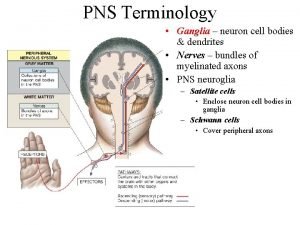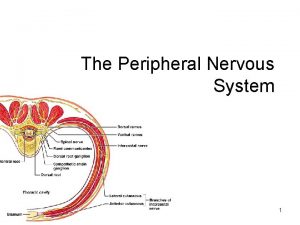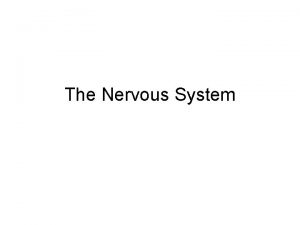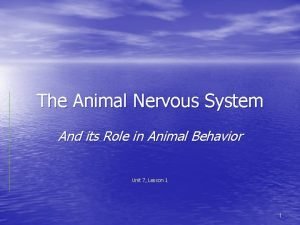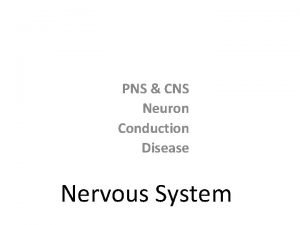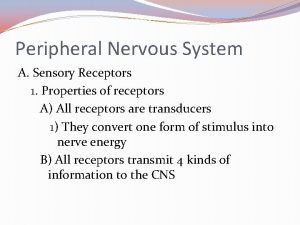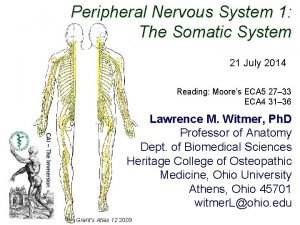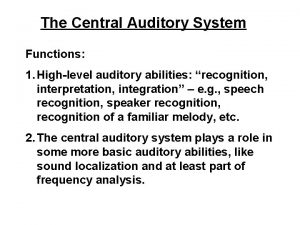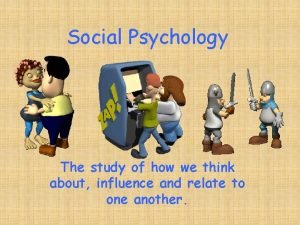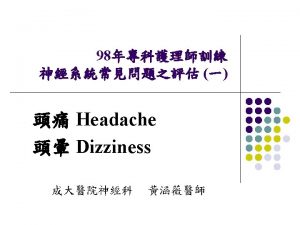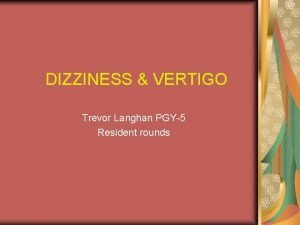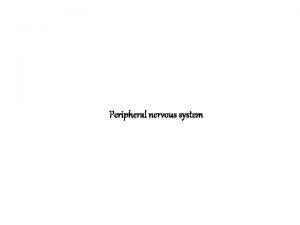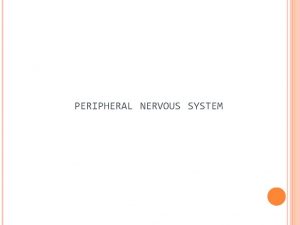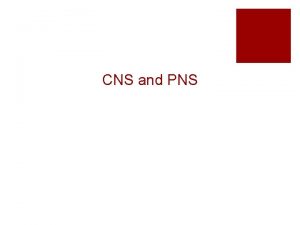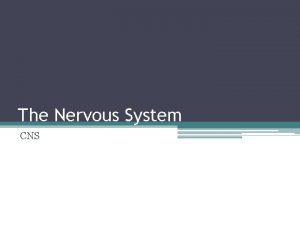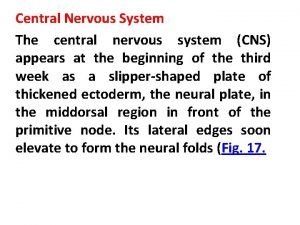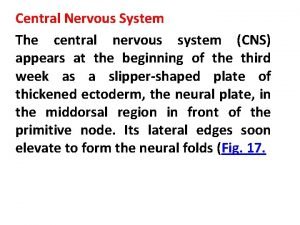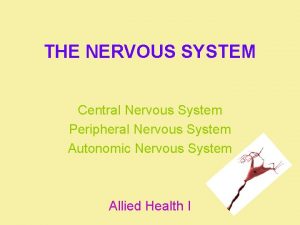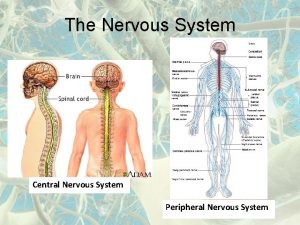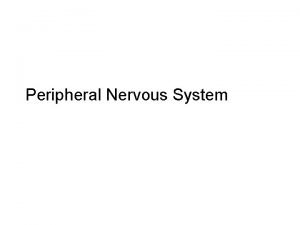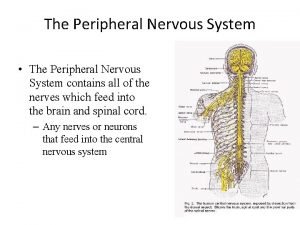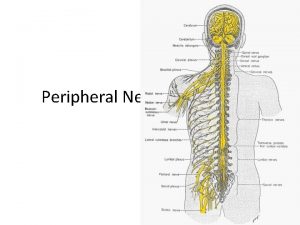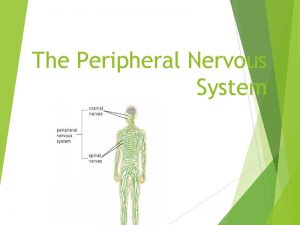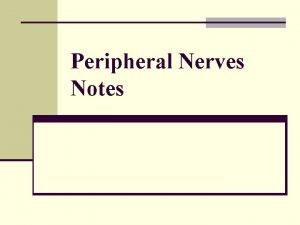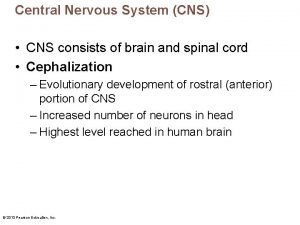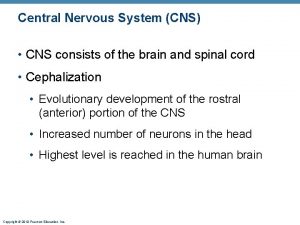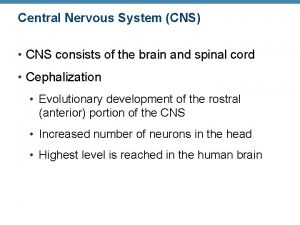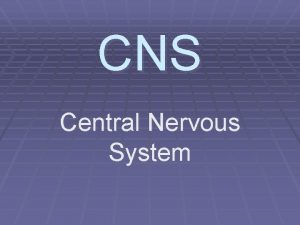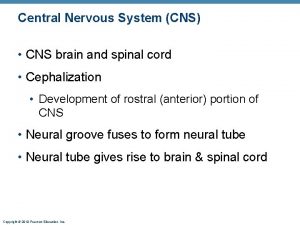Nervous System Central Nervous System CNS Peripheral Nervous















![Synapse [SIN-aps] a junction between the axon tip of the sending neuron and the Synapse [SIN-aps] a junction between the axon tip of the sending neuron and the](https://slidetodoc.com/presentation_image/1d709e38efab2954640639d931e961b3/image-16.jpg)









- Slides: 25

Nervous System Central Nervous System (CNS) Peripheral Nervous System (PNS) 1

"You have brains in your head. You have feet in your shoes. You can steer yourself Any direction you choose. ” Watch video: Human brain built for survival http: //videos. howstuffworks. com/discovery/6835 -human-body-built-for-survivalvideo. htm 2

Nervous System The brain is the center of the nervous system. The spinal cord and nerves are the connections. Nerves carry electrochemical signals to and from different areas of the nervous system as well as between the nervous system and other tissues and organs. Watch video clip: Neurons, how they work http: //www. neok 12. com/php/watch. php? v=z. X 784 a 525472754 f 71401 a 45&t=Nervous-System 3

The Nervous System: Consists of all the nerve cells. It is the body’s speedy, electrochemical communication system. Central Nervous System (CNS): the brain and spinal cord. Peripheral Nervous System (PNS): the sensory and motor neurons that connect the central nervous system (CNS) to the rest of the body. 4

The Nervous System 5

Peripheral Nervous System Somatic Nervous System: Part of the peripheral nervous system that controls the body’s skeletal muscles. Autonomic Nervous System: Part of the PNS that controls the glands and other muscles. The body’s automatic actions (eg. breathing and heartbeat) 6

Autonomic Nervous System (ANS) Sympathetic Nervous System: Division of the ANS that arouses the body, mobilizing its energy in stressful situations. Known as: FIGHT or FLIGHT response Parasympathetic Nervous System: Division of the ANS that calms the body, conserving its energy. Sympathetic vs Parasympathetic http: //www. garyfisk. com/anim/autonomicns. swf 7

Fight or Flight Response • fight or flight 8

Autonomic Nervous System (ANS) Sympathetic NS “Arouses” (fight-or-flight) Parasympathetic NS “Calms” (rest and digest) 9

Fainting Goats • fainting goat video 10

Neurons • The body’s information system is built from billions of interconnected cells called neurons. • A neuron is a nerve cell. • Neurons communicate with each other through an electrochemical process. • Neurons are the basic building blocks of the nervous system. • animation 11

Neuron A nerve cell, or a neuron, consists of many different parts. 12

Neuron Review • Neuron animation • http: //www. garyfisk. com/anim/neuronparts. swf • Neural transmission • http: //www. garyfisk. com/anim/neurotransmission. swf 13

Parts of a Neuron Cell Body: Life support center of the neuron. Dendrites: Branching extensions at the cell body. Receive messages from other neurons. Axon: Long single extension of a neuron, covered with myelin [MY-uh-lin] sheath to insulate and speed up messages through neurons. Terminal Branches of axon: Branched endings of an axon that transmit messages to other neurons. 14

Action Potential A neural impulse. A brief electrical charge that travels down an axon and is generated by the movement of positively charged atoms in and out of channels in the axon’s membrane. 15
![Synapse SINaps a junction between the axon tip of the sending neuron and the Synapse [SIN-aps] a junction between the axon tip of the sending neuron and the](https://slidetodoc.com/presentation_image/1d709e38efab2954640639d931e961b3/image-16.jpg)
Synapse [SIN-aps] a junction between the axon tip of the sending neuron and the dendrite or cell body of the receiving neuron. This tiny gap is called the synaptic gap or cleft. 16

Neurotransmitters (chemicals) released from the sending neuron travel across the synapse and bind to receptor sites on the receiving neuron, thereby influencing it to generate an action potential. 17

Neurotransmitters 18 Active psych synaptic transmission and neurotransmitters

The Endocrine System is the body’s “slow” chemical communication system. Communication is carried out by hormones synthesized by a set of glands. 19

Hormones are chemicals synthesized by the endocrine glands that are secreted in the bloodstream. Hormones affect the brain and many other tissues of the body. 20

Pituitary Gland • Is called the “master gland. ” It releases hormones that regulate other glands. • Releases the growth hormone. 21

Thyroid Glands Regulate metabolic rate. Produces a hormone called thyroxine. 22

Adrenal Glands and Pancreas Adrenal glands secrete hormones adrenaline (epinephrine and norepinephrine) during stressful and emotional situations. Pancreas secretes insulin to regulate the level of sugar in the blood. 23

Gonads • Sex glands are located in different places in men and women. They regulate bodily development and maintain reproductive organs in adults. • Testis produce the hormone testosterone. • The ovaries produce estrogen. 24

Pineal Gland Pineal gland produces Melatonin regulates the sleep cycle. 25
 Division of central nervous system
Division of central nervous system Central and peripheral nervous system
Central and peripheral nervous system Ganglion peripheral nervous system
Ganglion peripheral nervous system Peripheral nervous system
Peripheral nervous system Peripheral nervous system
Peripheral nervous system Peripheral nervous system consists of
Peripheral nervous system consists of Peripheral nervous system consists of
Peripheral nervous system consists of Wikimedia commons
Wikimedia commons Peripheral nervous system
Peripheral nervous system Pns
Pns Albuminocytologic dissociation
Albuminocytologic dissociation Migranal
Migranal Identify each type of neuronal pool
Identify each type of neuronal pool Nervous
Nervous What are neuron processes
What are neuron processes Peripheral nerves
Peripheral nerves Central nervous system amusement park
Central nervous system amusement park Cns
Cns Nervous tissue
Nervous tissue Bser aer
Bser aer Neuroglia
Neuroglia Central nervous system for kids
Central nervous system for kids Caloric test
Caloric test Central route to persuasion
Central route to persuasion Ottohrea
Ottohrea Peripheral vs central vertigo
Peripheral vs central vertigo


